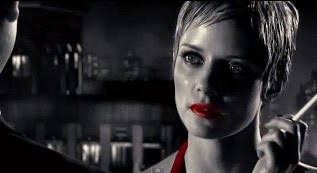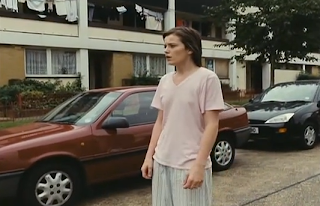Andrea Arnold's 2009 drama film, Fish Tank is a social realism film. Here I will be analysing three scenes from the film, where the film introduces the main protagonist, Mia.
Analysis 1:
(First 4 minutes of the film - 00:48 - 04:00)
This scene begins with the diegetic sound of Mia breathing heavily, suggesting that she has been running from something, but the reason why is later confirmed later in the film. It then cuts to an establishing shot of where she is, which gives the viewer an idea of her location. This is accompanied by diegetic sound of the urban environment and street below. This is supported by an panning shot of the landscape, with Mia still in the frame, showing housing tower blocks. The scene then cuts to a tracking shot, confirming Mia's environment, via the urban environment location, and her clothing, as she is wearing a vest, jogging bottoms, hooped earrings and chains, instantly stereotyping her as a 'chav', also the other people around her e.g. children playing/screaming. Most of the camera angles are handheld, or point of view shots, which is a very common element of the social realism genre conventions.
The mise-en-scene at the beginning of the scene gives us an idea of Mia's character, as her clothes suggest her background and social class. She makes a phone call, and her accent/language also tells us that she is working class or under class, as she states "Ring me back you bitch". Her southern accent and very informal language throughout the scene also gives the viewer an idea of her upbringing and education, as she is a 15 year-old girl and is instantly swearing.
The last part of this scene shows Mia confront her friend Keeley, and a group of girls dancing. Again, the camera is handheld, in a documentary type style. The narrative throughout the film is basic, and we are instantly introduced to the main character, seeing events from her point of view, telling us that the film is about Mia, as social realism films are about events and issues of everyday life. The music at the end of the scene also creates an urban environment, as the girls are dancing to hip-hop music and dressed very provocatively, with low-cut tops, shorts, hooped earrings and trainers. There is also a group of lads watching the girls dancing, going against the Laura Mulvey (1975) male gaze theory, applying the female gaze. Mia is also violent to one of the girls, head butting her after a confrontation, showing violence within the young girls and environment.
Analysis 2:
(The scene just after Mia has sex with Connor - 1:22:20 - 1:25:45)
This is the scene just after Mia sleeps with her Mother's boyfriend, Connor. Mia wakes up to the sound of her Mother crying, and goes into her room. The sound of the scene is all diegetic, including the speech, footsteps running and Connor's car driving away.
The handheld tracking camera movement following Mia as she is running from the flat to Connor gives the film a sense of realism, and almost allows the viewer to see the events unfold from Mia's point of view. The diegetic sound of Mia's heavy breathing also gives a sense of realism to the scene.
At this point in the film we already know about Mia's character and social class, however this is supported by the furnishings in the flat, the location of the flat, and the clothing of Mia, her little sister and her mother, which is a part of the mise-en-scene.
Mia goes on a mission to track down Connor, and as she is walking down the street, her friend Billy attempts to speak to her. The camera angle is handheld and at constant eye level, with high key lighting, showing realism, as most of this scene is filmed outdoors.
Analysis 3:
(Last scene of the film - 1:57:27 - 1:59:28)
This scene is the last scene of the film, where Mia is leaving London to go and live with Billy in Wales. Mia is shown walking through a door with the sign "Fire Exit" sign, showing that she is finally escaping her life in the tower block.
Applying to Propp's theory, Billy acts as a hero, as he is helping Mia to escape her life in London and the troubles of the recent events. As the car is driving away, Mia's little sister, Tyler shouts "Bye you skank, don't forget to text me, say hello to the world for me", suggesting that as Mia is escaping from her mundane life, her sister is trapped there in the 'fish tank', unable to escape as she is so young.
As the scene ends, a balloon in the shape of a loveheart is seen floating away from the tower block, again, suggesting that the balloon is representing Mia, and is finally escaping from the tower block, however Mia would probably repeat her mistakes in Wales, as her Mother has set a bad example to her from a young age, of having numerous boyfriends, drinking and smoking.
The sound of the scene is completely diegetic, until the end titles, and the camera movement is handheld, giving a sense of realism.
Conclusion:
In conclusion, the film/these three scenes contain many conventions of the social realism genre, including the completely diegetic sound and handheld camera movements. The narrative is simple throughout, applying to Todorov's theory of equilibrium. The only real problems within the film begin when Connor arrives and disrupts the equilibrium. The new equilibrium occurs when Mia escapes to Wales with Billy, finally suggesting a happy ending for Mia.











